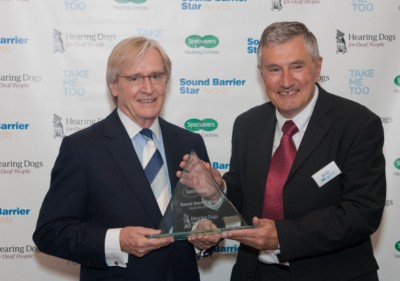Elixir was at the Sound Barrier Awards last week to see Corrie favourite William Roache OBE speak about hearing loss and pay tribute to the worthy winner of the title of Specsavers ‘Sound Barrier Star’.
The event, also sponsored by Hearing Dogs for Deaf People, celebrates people with some form of hearing loss who have not let their condition stand in their way.
Before introducing each of the nominees William, better known for his role as Corrie favourite Ken Barlow, said a few words about his partial hearing loss and the surprising fact that only 10% of people will ever have a hearing test, in comparison with the 80% who get their eyes tested.
The ‘Sound Barrier Star’, Roger Hewitt, from Bromley, accepted his prize with a very humorous and humbling speech. He has been deaf since the age of 6 as a result of contracting meningitis and now is an ambassador, volunteer and consultant for the cause. It certainly seems like he has never let his deafness affect his life and is an example for us all.
We caught up with William for a quick chat afterwards. He told us that he suffered some ear damage from a mortar bomb as a 21 year old in the army; his hearing came back after 3 weeks but he never realised the extent of the damage until recently. After having a hearing test he was told that he had 50% hearing loss. William confided that he has hearing aids but he doesn’t use them very often at all. He doesn’t feel like his hearing loss is a barrier in any way to his life.
William is lucky to have enjoyed enviable longevity onscreen as Ken Barlow; only Don Hastings, who plays Bob Hughes on US show ‘As The World Turns’, has dedicated a longer service to Soap-dom. William confirmed that he loves playing Ken and is very proud to still be in Corrie after all these years. It’s a long day on set – 8am to 7pm – but he hasn’t got fed up of it yet!
The evolution of Corrie into the nation’s longest running soap is something which would have surprised the creators of the programme 50 years ago: William remarked that the name of ‘soap’ was something which Coronation Street had tried to avoid for many years – having marketed themselves as a cutting-edge drama series to begin with.
We concluded that one of the refreshing things about soaps, or cutting edge drama series (!), is that they do resemble ordinary people’s lives in some way – you are allowed to get older on screen and the more senior characters become something of an institution rather than fading into the background.
To learn more about Specsavers hearing centres, or to book a hearing test, please visit www.specsavers.co.uk/hearing/

